Khanom chan (also kanom chan) is unlike any Western dessert you're likely to come across, but if you like sticky and tacky East Asian sweets then this is most certainly a recipe worth your time and effort. Yes, it's time consuming – once the dough is prepared, each of the many layers is steamed individually. Expect to spend a couple of hours, maybe a little less if you aren't prone to the constant distraction that I am, preparing and steaming this layer cake.
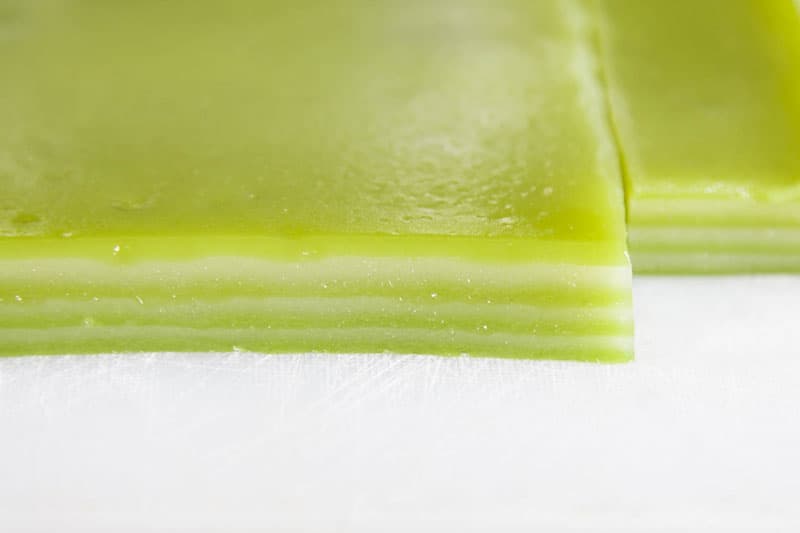
In Thai, the word khanom (or kanom) is a reference to sweets and snacks and chan to floors or layers. Traditionally this sweet should have nine layers. According to this book the numerical significance references upward mobility in rank within the Thai civil service.
No one is going to lose sleep if your kanom chan is a layer or two more or less. It's fairly common to come across moulded kanom chan nowaways and sometimes these don't have layers at all.
You can also make khanom chan into a rainbow dessert by colouring the various layers with food dye. Just add a drop or 5 of food colouring to each portion, depending on how bold you want the colour to be, and mix well to distribute the dye in the flour slurry before steaming.
Of course pandan and jasmine are traditional flavours, but rose and orange waters, as well as other flavourings, can make for an equally delicious khanom chan. Coffee is also quite common.
📖 Recipe
Thai Khanom Chan Recipe ขนมชั้น
Equipment
- steamer
Ingredients
- 1 tin/can coconut milk (400 millilitres) NOT reduced fat
- 250 grams white sugar
- 100 grams arrowroot flour
- 40 grams tapioca flour
- 30 grams non-glutinous rice flour
- Pinch of salt
- 200 millilitres jasmine water made by steeping a few jasmine flowers – dried are fine – in water overnight OR with a few drops of jasmine essence
- 3-4 pandan leaves, cut into 1 inch pieces chopped into ¼ inch pieces OR a combination of pandanus extract and green food dye
- Food colouring optional
Instructions
- Combine the coconut milk and sugar in a saucepan. Cook on medium heat just until the sugar is dissolved, avoiding bringing the liquid to the boil. Set aside until completely cool.
- Add plenty of water to the base of your steamer (recommended: a tiered metal Chinese steamer) and heat to a slow steady boil. Place a 10 x 10 inch tray onto a tier in your steamer and leave for 20 minutes to until very hot.
- Mix the flours and salt together in a bowl. Whisk the cooled sweetened coconut milk into the bowl, ensuring there are no lumps by straining the mix through a fine mesh sieve. Evenly divide the mixture into two portions.
- Make the pandan water by blending half of the jasmine water with the pandan leaves. Strain the pandan water into one half of the divided coconut mix with a fervour, pressing with as much effort as you can muster to extract all of the liquid (and flavour). Add the remaining 100 millilitres of jasmine water to the other half of the coconut mixture.
- Pour a very thin layer of either mix into the tray, aiming for just a couple or 3 millimetres in thickness (around ⅓ cup per layer in a 10×10 tray). Tip the steamer slightly, if necessary, so that the dough evenly covers the bottom of the tray. Steam for 12-15 minutes, during which time the layer will set and will appear dry with an even opaque look. Carefully remove the lid, wiping it with a tea towel to keep water from dripping onto the cake (if using a Chinese steamer with a domed lid).
- Add the second layer, again with the same minimal thickness, and steam for a further 12-15 minutes. Repeat, alternating white and green layers, until you have used all of the slurry. Remember to top up the steaming water if it gets low and to always wipe the lid each time you remove it. After adding the final layer, steam for 20-25 minutes to set.
- Set aside to cool completely before cutting and serving. Khanom chan is best on the day it’s made, but will last a few more at a stretch and about a week in the fridge (although the texture may become slightly less chewy.

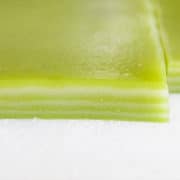
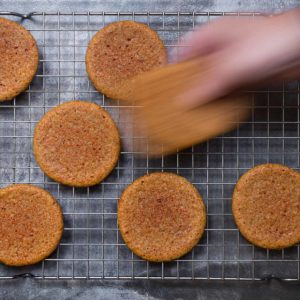
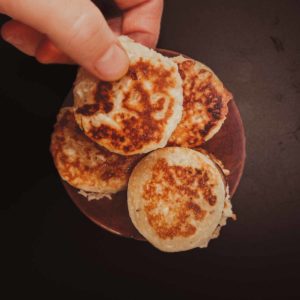
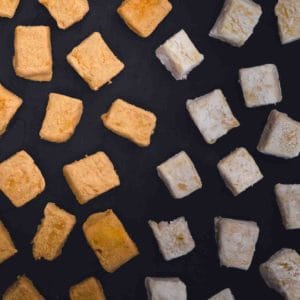

Caitlin says
I love all your recipes because you so often have something completely new to me! I've never had khanom chan but it looks interesting!
Kip says
aw thanks! All that compulsive grocery shopping...
Tasneem says
What is non glutinous rice flour? Can i use glutinous rice flour instead?
Kip says
Non glutionous rice flour is rice flour made from non glutinous rice. It's easy to find in any East Asian store. It provides some structure that sticky rice/glutinous rice flour won't.
Vee says
I’m Thai and I live in the USA since I was a kid.. I remembered all the food I ate while living in Thailand.. I’m 55 now and stumbled across your recipe.. I love it… I sometime get fresh pandan leaves from my Mom’s garden instead of the bottle kind.. 😋😋😋
Kip says
Nothing beats fresh pandan! I use the bottle kind sometimes but I find it is less nutty tasting than using the leaves...
Isabella says
Hi there. I live Kanom Chan dessert. I want ask you is it 1400 milliliter or 1 400 milliliter coconut milk?
Kip says
Hi Isabella, it should be one 400 ml tin. I'll change the way the ingredient is listed so it's less confusing. Thanks for pointing it out!
I reserve the right to improve malicious and trollish comments.